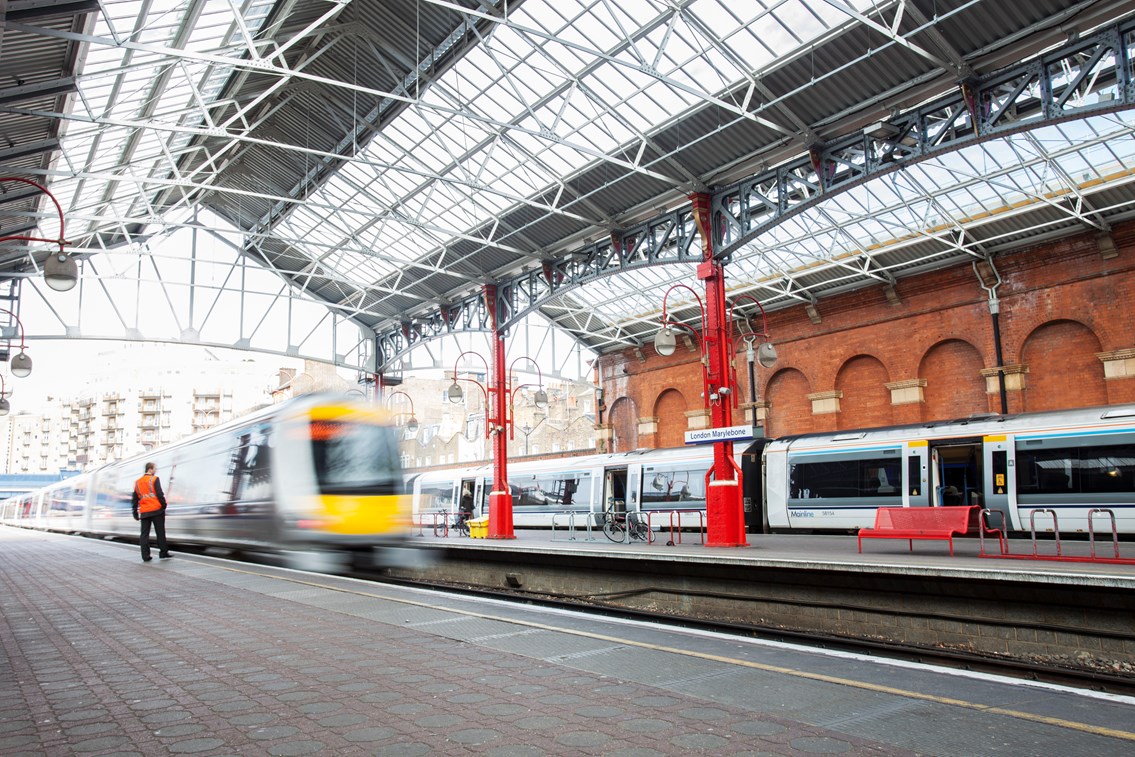Monday 4 Jul 2016
Longer trains, new track, upgraded stations - planning for future demand for rail travel in the West Midlands and Chilterns
- Region & Route:
- | North West & Central
Longer trains and platforms, more services and upgraded stations are among the steps proposed to meet a forecast 49% increase in demand for rail travel in the West Midlands and Chilterns regions over the next seven years.
An additional 24 million annual passenger journeys will take place in these areas by 2023, according to industry forecasts.
The West Midlands and Chiltern routes, which links Birmingham and the West Midlands with London via towns in Warwickshire, Oxfordshire and Buckinghamshire, already caters for more than 50 million passenger journeys every year – a number predicted to increase to more than 100 million journeys every year by 2043.
Through its multi-billion pound Railway Upgrade Plan, Network Rail is already delivering significant improvements across Britain to provide passengers with a better railway and help boost economies. Recent examples in the West Midlands include the £750m redevelopment of Birmingham New Street station and the £250m upgrade of the railway near Stafford. The new link between Oxford Parkway, and eventually Oxford, to the Chiltern main line, which was delivered in partnership with Chiltern Railways, is another example in the Chilterns region.
Network Rail and its rail industry partners have led a process to inform the West Midlands and Chilterns Route Study, which outlines the capacity challenges and has developed potential options for funders to improve future services for passengers and freight.
While the proposed HS2 will provide more frequent, faster services from the West Midlands and surrounding areas to London, there is a need to upgrade the existing railway so passengers can easily access HS2 and these benefits and continue to be able to commute across the region by rail.
The study identifies a number of potential options for capacity and capability improvements to enable the railway to continue to connect people to jobs and promote economic growth over the next 10 to 30 years.
These potential options include:
- Longer trains on key commuter and long distance routes in to the West Midlands by 2024
- The development of the ‘Midlands Rail Hub’ concept which could enable more train services to run every hour into central Birmingham and provide improved connections between the East and West Midlands
- Options for the Midland Rail Hub include:
- New infrastructure at Bordesley to enable services from the south west, north east and East Midlands to access Birmingham Moor Street
- Additional tracks through the Water Orton corridor to provide capacity for additional passenger between Birmingham and the East Midlands and more freight services
- An upgrade in the Kings Norton station area and more platforms at Birmingham Snow Hill and Birmingham Moor Street stations
- Longer trains into London Marylebone during peak times by 2024
- A new connection from the Chiltern Line to the new interchange at Old Oak Common in West London, to provide additional capacity and access to HS2 and Crossrail services
- Upgrade of the railway in the Worcester area to improve reliability
- Using digital technology to control trains on the rail network providing extra capacity, more reliable services and improved information.
Martin Frobisher, route managing director for Network Rail, said: “It is vital that the rail industry continues to prepare for future challenges, not least how more people can access a vastly improved and expanded railway.
“Across the West Midlands and Chilterns, there is much to do to meet predicted demand. This study outlines possible options. The impact of HS2 will be huge and it is vital the existing railway connects with the new and the benefits it will deliver.
“The railway is Britain’s economic lifeblood. Our multi-billion pound Railway Upgrade Plan is already delivering better services for passengers and boosting our economy, as highlighted by the redevelopment of Birmingham New Street station and the connection of Oxford Parkway station to the Chiltern main line. The potential options outlined in this study will help ensure this success continues long into the future.”
The publication of the study starts a 90-day consultation where interested parties can comment on the strategy to help inform the final version which is due to be published later this year. The strategy will be used to help identify the proposals which could be taken forward for further development in the next and future control periods.
Comments can be submitted via westmidlandsandchilternsroutestudy@networkrail.co.uk or at https://www.networkrail.co.uk/long-term-planning-process/West-Midlands-and-Chilterns-Route-Study/
Partners involved in the development of the route study include the Department for Transport, Office of Road and Rail (ORR), the West Midlands Combined Authority and passenger and freight operators.
Contact information
Passengers / community members
Network Rail national helpline
03457 11 41 41
Latest travel advice
Please visit National Rail Enquiries
Journalists
Network Rail press office - North West & Central Region
07740 782954
NWCmediarelations@networkrail.co.uk
About Network Rail
We own, operate and develop Britain's railway infrastructure; that's 20,000 miles of track, 30,000 bridges, tunnels and viaducts and the thousands of signals, level crossings and stations. We run 20 of the UK's largest stations while all the others, over 2,500, are run by the country's train operating companies.
Usually, there are almost five million journeys made in the UK and over 600 freight trains run on the network. People depend on Britain's railway for their daily commute, to visit friends and loved ones and to get them home safe every day. Our role is to deliver a safe and reliable railway, so we carefully manage and deliver thousands of projects every year that form part of the multi-billion pound Railway Upgrade Plan, to grow and expand the nation's railway network to respond to the tremendous growth and demand the railway has experienced - a doubling of passenger journeys over the past 20 years.
Follow us on Twitter: @networkrail
Visit our online newsroom: www.networkrailmediacentre.co.uk

